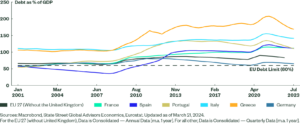Before implementing a covered call writing strategy, investors need to consider several factors in order to make an informed decision. This final article in a series of four articles on covered call writing will discuss the choice of a strike price for a call option as a compromise between the desired level of protection and the potential gain on the strategy. You will see how the return on a strategy and the level of protection varies, depending on the expiration you choose. Lastly, you will see the potential impact of dividends on the premature exercise of call options.
Selecting a strike price
Table 1: Level of protection and potential gain on July 9, 2020
(XIU at $23.65, call options expiring September 18, 2020)
| Strike | Premium | Level of protection(break-even price) | Potential gain(maximum profit per share) |
| $26 | $0.09 | $23.56 | $2.44 |
| $25 | $0.24 | $23.41 | $1.59 |
| $24 | $0.65 | $23.00 | $1.00 |
| $23 | $1.26 | $22.39 | $0.61 |
| $22 | $2.06 | $21.59 | $0.41 |
Source: Montréal Exchange
The above table shows the level of protection provided by some XIU[1] call options maturing on September 18, 2020 based on a series of different strike prices ($22 to $26), comparing it to the potential gain of the strategy on July 9, 2020, when XIU was trading at $23.65. As the table shows, the higher the strike, the lower the premium and the less protection provided. However, we can see that a higher strike also offers a superior potential gain (the out-of-the-money call options). The options with a $26.00 strike have a break-even point of $23.56 (XIU’s current price of $23.65 – the $0.09 premium) and offer a maximum potential gain of $2.44 on the upside (the $26.00 strike + the $0.09 premium – XIU’s current price of $23.65). The options with a $24.00 strike (call options that are almost at-the-money) have a break-even point of $23.00 (XIU’s current price of $23.65 – the $0.65 premium) and offer a maximum potential gain of $1.00 on the upside (the $24.00 strike + the $0.65 premium – XIU’s current price of $23.65). Lastly, the options with a $22.00 strike (in-the-money call options) have a break-even point of $21.59 (XIU’s current price of $23.65 – the $2.06 premium) and offer a maximum potential gain of $0.41 on the upside (the $22.00 strike + the $2.06 premium – XIU’s current price of $23.65). The same approach also applies to all the other strike prices in the table. Given the results of this exercise, we can only conclude that the choice of a strike is necessarily a compromise between the desired level of protection and the maximum potential gain resulting from an increase in the security’s price.
Choosing an expiration date
Table 2: Level of protection and potential gain as of July 9, 2020
(XIU at $23.65, call options with $24 strike)
| Expiration date | Number of days to expiration | Premium | Daily premium | Level of protection(break-even price) | Potential gain(maximum profit per share)XIU >= $24 | Maximum return(annualized) | Annual static return |
| 17/07/2020 | 8 | $0.10 | $0.0125 | $23.55 | $0.45 | 1.91%(87%) | 19% |
| 21/08/2020 | 12 | $0.50 | $0.0116 | $23.15 | $0.85 | 3.67%(31%) | 18% |
| 18/09/2020 | 71 | $0.65 | $0.0092 | $23.00 | $1.00 | 4.35%(22%) | 15% |
| 19/03/2021 | 253 | $1.40 | $0.0055 | $22.25 | $1.75 | 7.87%(11%) | 9% |
| 18/03/2022 | 617 | $2.10 | $0.0034 | $21.55 | $2.45 | 11.37%(7%) | 6% |
Source: Montréal Exchange
The above table compares the level of protection and potential gain provided by certain XIU call options with a $24 strike according to their expiration dates (from July 17, 2020 to March 18, 2022) as of July 9, 2020, when XIU was trading at $23.65. As the table shows, the later the expiration date, the higher the premium on the call option and more protection it provides. The main difference between options with the same strike but different expiration dates is what is called the average daily time-value decay of the option premium. In the options in this table the premium consists entirely of time value, since the strike is higher than the price of the underlying asset. They are therefore called “out-of-the-money” options. If they are at expiration, the holder will have no interest in exercising them; they will be worthless. Therefore, by dividing the premium (consisting entirely of time value) by the number of days to expiration, we can derive a sort of daily theta.[2] The table clearly shows that as the number of days increases, the daily theta decreases. For example, options expiring on July 17, 2020 have an average daily time-value decay of $0.0125, while options expiring on March 18, 2022 have an average daily time-value decay of $0.0034. This is also evident in the maximum annualized return, which is 87% for the July 17, 2020 maturity and 7% for the March 18, 2022 maturity. This means that if we could sell 8-day options every 8 days for a year and we were able to get the maximum profit each time, we would realize a return for the year of 87%.
In addition to the maximum potential return, we also calculated the static annual return, i.e. the return that could be earned if the security continued to trade at close to the same price until expiration and we were able to repeat the transactions for a full year. In such a case, the return would be the premiums received. Once again, we note that the more days remaining to expiration, the lower the static return.
It therefore becomes clear that, much like choosing a strike, choosing an expiration is a compromise between the desired level of protection and the maximum or static return.
Potential impact of dividends: the premature exercise of call options
The last issue you should be aware of before implementing a covered call writing strategy concerns the dividends that may be paid by some companies. In order to collect dividends, you must own the securities. But in order to implement the strategy, you need to own the underlying assets and write calls, which means that you must sell the assets if the calls are exercised by the holder. When the security pays a dividend, you might think that you will automatically receive it because you own the securities, but this is far from certain. If the price of the stock is higher than the calls’ strike on the day before the ex-dividend date,[3] it may be in the best interests of the holder of the call options to exercise them in order to acquire the securities and receive the dividends. In such a case you will lose your securities and consequently not receive the dividends paid. So when implementing this strategy on a dividend-paying stock, you need to be aware that you could lose your shares or units on the day before the ex-dividend date. To prevent this from occurring, you need to close the call option position by buying back the options.
Conclusion
There are several issues to consider before you implement a covered call writing strategy. The first is which strike to choose and the second is which expiration to choose. Both decisions involve a compromise between the level of protection provided by the strategy and the maximum desired return. The higher the level of protection, the lower the potential return. Conversely, the higher the desired return, the lower the protection. There are no free lunches in finance. Lastly, if the security on which the strategy is implemented pays a dividend, you must be aware that you could lose your shares or units the day before the ex-dividend date.
This concludes this series on covered call writing. We encourage you to visit Montréal Exchange’s website for more educational material on the subject and to consult the dates of upcoming webinars on this and other topics.
“Before you start using the strategies mentioned in this article, we suggest that you test them using the Montréal Exchange’s trading simulator.
Good luck with your trading, and have a good week!
[1] The iShares S&P/TSX 60 ETF
[2] Theta is one of the Greek variables, which are used to measure the sensitivity of an option’s price to fluctuations in the various factors that can affect its value. In this case, daily theta measures the change in the option price from one day to the next. For the purposes of this article we have calculated what in reality is not the true daily theta but rather the average daily time-value decay.
[3] The day before the ex-dividend date is the last date on which someone can buy the shares to receive the dividends paid. If the shares are purchased on the ex-dividend date, the purchaser will not receive the dividends paid.
—
Originally Posted on October 15, 2020 – Writing Covered Calls — Some Points to Consider
Dollars expressed are in CAD
The strategies described in this blog are for information and training purposes only. They should not be interpreted as recommendations to buy or sell any security. As always, you should ensure that you are comfortable with the proposed scenarios and ready to assume all the risks before implementing an option strategy.
Disclosure: Montréal Exchange - Option Matters
This material is from Bourse de Montréal Inc. and is being posted with its permission. Opinions expressed in this document do not necessarily represent the views of Bourse de Montréal Inc.
This document is made available for general information purposes only. The information provided in this document, including financial and economic data, quotes and any analysis or interpretation thereof, is provided solely for information purposes and shall not be construed in any jurisdiction as providing any advice or recommendation with respect to the purchase or sale of any derivative instrument, underlying security or any other financial instrument or as providing legal, accounting, tax, financial or investment advice. Bourse de Montréal Inc. recommends that you consult your own advisors in accordance with your needs before making decision to take into account your particular investment objectives, financial situation and individual needs.
Although care has been taken in the preparation of this document, Bourse de Montréal Inc. and/or its affiliates do not guarantee the accuracy or completeness of the information contained in this document and reserve the right to amend or review, at any time and without prior notice, the content of this document.
Neither Bourse de Montréal Inc. nor any of its affiliates, directors, officers, employees or agents shall be liable for any damages, losses or costs incurred as a result of any errors or omissions in this document or of the use of or reliance upon any information appearing in this document.
Disclosure: Canadian Options Trading
Canadian Listed Options involve risk and are not suitable for all investors. Trading of certain standardized Canadian Listed Options may not be permitted for U.S. Residents. For more information read the Characteristics and Risks of Listed Canadian Standardized Options, also known as the options disclosure document (ODD). To receive a copy of the ODD call 877-745-4222 or copy and paste this link into your browser: https://www.cdcc.ca/f_en/Options_Disclosure.pdf
Disclosure: Interactive Brokers
Information posted on IBKR Campus that is provided by third-parties does NOT constitute a recommendation that you should contract for the services of that third party. Third-party participants who contribute to IBKR Campus are independent of Interactive Brokers and Interactive Brokers does not make any representations or warranties concerning the services offered, their past or future performance, or the accuracy of the information provided by the third party. Past performance is no guarantee of future results.
This material is from Montréal Exchange - Option Matters and is being posted with its permission. The views expressed in this material are solely those of the author and/or Montréal Exchange - Option Matters and Interactive Brokers is not endorsing or recommending any investment or trading discussed in the material. This material is not and should not be construed as an offer to buy or sell any security. It should not be construed as research or investment advice or a recommendation to buy, sell or hold any security or commodity. This material does not and is not intended to take into account the particular financial conditions, investment objectives or requirements of individual customers. Before acting on this material, you should consider whether it is suitable for your particular circumstances and, as necessary, seek professional advice.
Disclosure: Options Trading
Options involve risk and are not suitable for all investors. Multiple leg strategies, including spreads, will incur multiple commission charges. For more information read the "Characteristics and Risks of Standardized Options" also known as the options disclosure document (ODD) or visit ibkr.com/occ












![[Gamma] Scalping Please [Gamma] Scalping Please](https://ibkrcampus.com/wp-content/smush-webp/2024/04/tir-featured-8-700x394.jpg.webp)
![[Gamma] Scalping Please [Gamma] Scalping Please](https://ibkrcampus.com/wp-content/uploads/2024/04/tir-featured-8-700x394.jpg)










![[Gamma] Scalping Please [Gamma] Scalping Please](https://ibkrcampus.com/wp-content/smush-webp/2024/04/tir-featured-8-300x169.jpg.webp)
![[Gamma] Scalping Please [Gamma] Scalping Please](https://ibkrcampus.com/wp-content/uploads/2024/04/tir-featured-8-300x169.jpg)